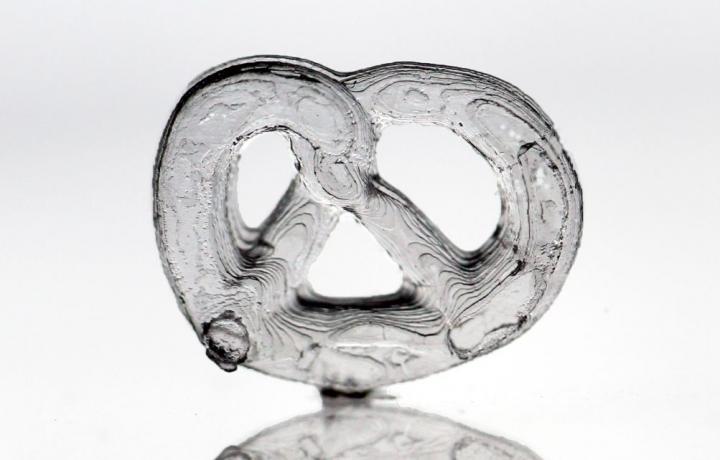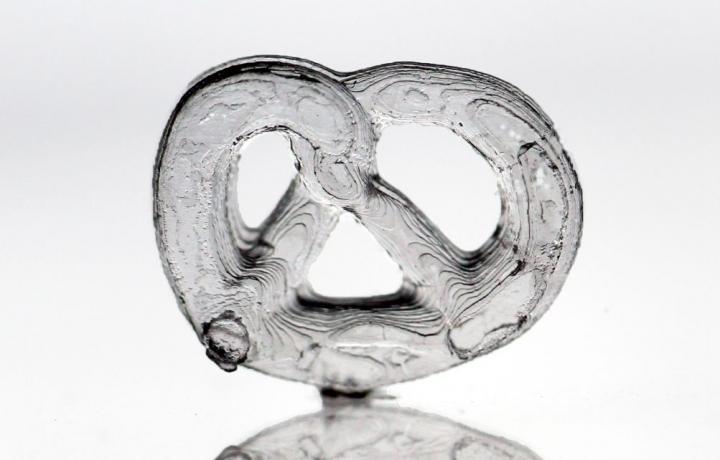
Credit: KIT
Glass is one of mankind's oldest materials. It was used as far back as in ancient Egypt and ancient Rome and has found a place now also in manufacturing technology of the 21st century. An interdisciplinary team at the KIT led by mechanical engineer Dr. Bastian E. Rapp developed a process using glass for additive manufacturing techniques. The scientists mix nanoparticles of high-purity quartz glass and a small quantity of liquid polymer and allow this mixture to be cured by light at specific points – by means of stereolithography. The material, which has remained liquid, is washed out in a solvent bath, leaving only the desired cured structure. The polymer still mixed in this glass structure is subsequently removed by heating. "The shape initially resembles that of a pound cake; it is still unstable, and therefore the glass is sintered in a final step, i.e. heated so that the glass particles are fused," explains Rapp. He conducts research at the KIT Institute of Microstructure Technology and heads a working group of chemists, electrical engineers, and biologists. The scientists present the method in the Nature journal under the title of "Three-dimensional Printing of Transparent Fused Silica Glass."
The variety of 3D-printing techniques available so far have been used on polymers or metals, but never on glass. Where glass was processed into structures, for instance by melting and application by means of a nozzle, the surface turned out to be very rough, the material was porous and contained voids. "We present a new method, an innovation in materials processing, in which the material of the piece manufactured is high-purity quartz glass with the respective chemical and physical properties," explains Rapp. The glass structures made by the KIT scientists show resolutions in the range of a few micrometers – one micrometer corresponding to one thousandth of a millimeter. However, the structures may have dimensions in the range of a few centimeters, emphasizes Rapp.
3D-formed glass can be used, for instance, in data technology. "The next plus one generation of computers will use light, which requires complicated processor structures; 3D-technology could be used, for instance, to make small, complex structures out of a large number of very small optical components of different orientations," explains the mechanical engineer. For biological and medical technologies, very small analytical systems could be made out of miniaturized glass tubes. In addition, 3D-shaped microstructures of glass could be employed in a variety of optical areas, from eyeglasses meeting special requirements to lenses in laptop cameras.
The development by scientists under Junior Scientist Group Leader Bastian E. Rapp is a result of the "NanoMatFutur" junior scientist funding scheme run by the German Federal Ministry for Education and Research (BMBF) to support the development of innovative materials for industry and society. The work performed by the research group headed by Rapp has been funded by the BMBF since 2014 for a total of four years to the tune of approx. € 2.8 million. "Our research benefits very much from the interdisciplinary cooperation of various KIT institutes. Besides the Institute of Microstructure Technology, colleagues of the Institute of Nuclear Waste Management and the Institute of Applied Materials, among others, are involved in the project," says Rapp.
###
Videos and more information about the current publication and the precursor project can be found under http://www.pkm.kit.edu/english/true3dglass.php
The technology presented here is one of the topics shown at the KIT booth at the Hanover Fair between April 24 and 28, 2017 (Hall 2, B16 – "Research and Technology"). Further information can be found under http://www.kit.edu/kit/english/pi_2017_045_hannover-messe-innovative-technologies-for-the-energy-transition-e-mobility-and-materials-sciences.php?
Frederik Kotz, Karl Arnold, Werner Bauer, Dieter Schild, Nico Keller, Kai Sachsenheimer, Tobias M. Nargang, Christiane Richter, Dorothea Helmer, Bastian E. Rapp: Three-Dimensional Printing of Transparent Fused Silica Glass. Nature
Karlsruhe Institute of Technology (KIT) pools its three core tasks of research, higher education, and innovation in a mission. With about 9,300 employees and 25,000 students, KIT is one of the big institutions of research and higher education in natural sciences and engineering in Europe.
KIT – The Research University in the Helmholtz Association
afr, 20.04.2017
For further information, please contact:
Margarete Lehné
Pressereferentin
Phone: +49 721 608-48121
Fax: +49 721 608-45681
[email protected]
Media Contact
Monika Landgraf
[email protected]
49-721-608-47414
@KITKarlsruhe
http://www.kit.edu/index.php
############
Story Source: Materials provided by Scienmag





